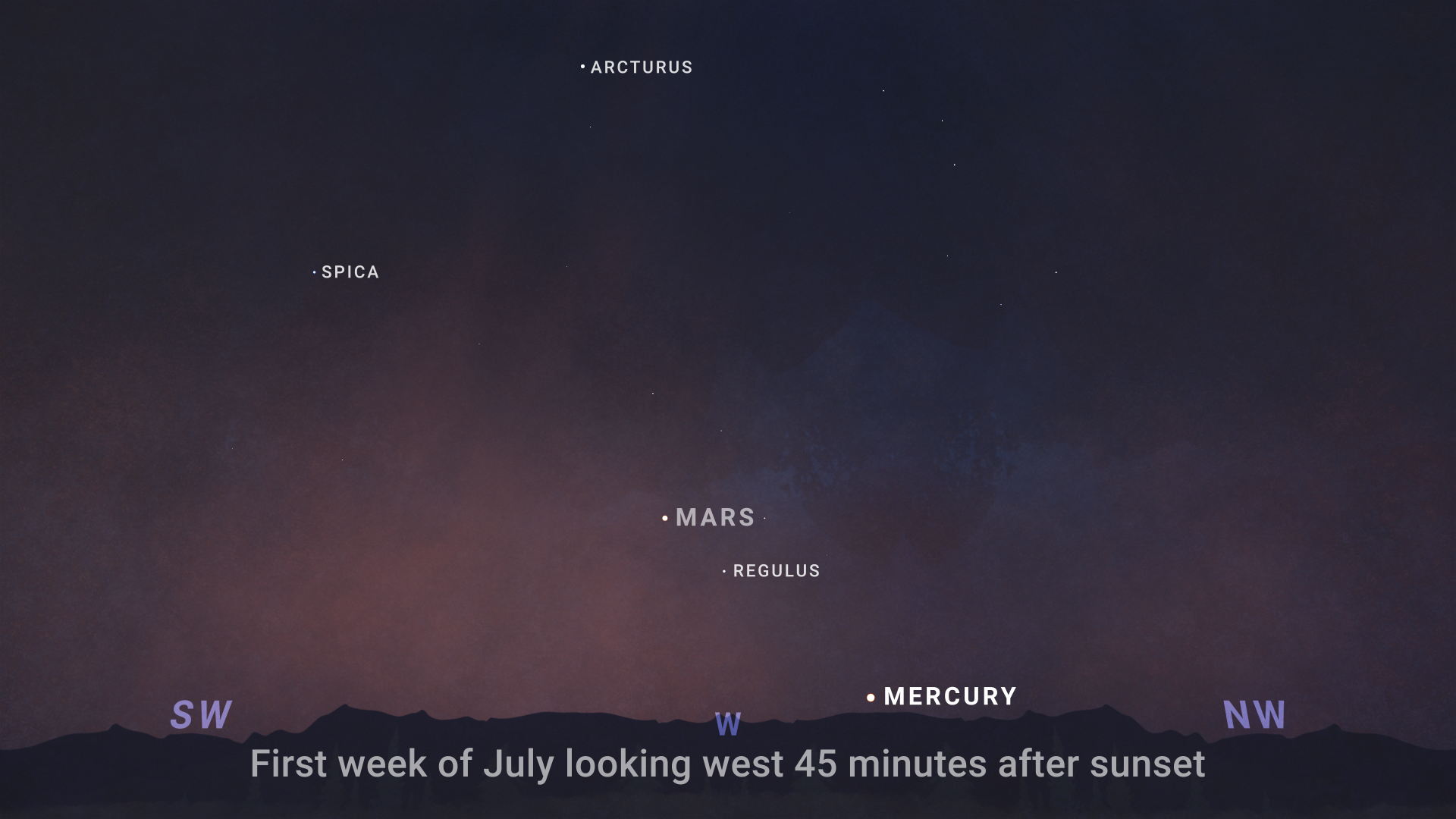A.M./P.M. Planet Watching, Plus the Eagle Constellation
Mars shines in the evening, and is joined briefly by Mercury. Jupiter joins Venus as the month goes on. And all month, look for Aquila the eagle.
Skywatching Highlights
All Month – Planet Visibility:
Daily Highlights:
July 1 – 7 – Mercury is relatively bright and easy to spot without a telescope, beginning about 30-45 minutes after sunset for the first week or so of July. You will need an unobstructed view toward the horizon, and note that it sets within an hour after the Sun.
July 21 & 22 – Moon, Venus, & Jupiter – Look toward the east this morning to find a lovely scene, with the crescent Moon and Venus, plus several bright stars. And if you have a clear view toward the horizon, Jupiter is there too, low in the sky.
July 28 – Moon & Mars – The crescent Moon appears right next to Mars this evening after sunset.
All month – Constellation: Aquila – The Eagle constellation, Aquila, appears in the eastern part of the sky during the first half of the night. Its brightest star, Altair, is the southernmost star in the Summer Triangle, which is an easy-to-locate star pattern in Northern Hemisphere summer skies.
Transcript
What’s Up for July? Mars shines in the evening sky, sixty years after its first close-up,
July Planet Viewing
Venus brightens your mornings, and the eagle soars overhead.
First up, Mercury is visible for a brief time following sunset for the first week of July. Look for it very low in the west 30 to 45 minutes after sundown. It sets within the hour after that, so be on the ball if you want to catch it!
Mars is visible for the first hour or two after it gets dark. You’ll find it sinking lower in the sky each day and looking a bit dimmer over the course of the month, as our two planets’ orbits carry them farther apart. The crescent Moon appears right next to Mars on the 28th.
Sky chart showing Mercury and Mars in the western sky following sunset in early July. NASA/JPL-CaltechJuly is the 60th anniversary of the first successful flyby of Mars, by NASA’s Mariner 4 spacecraft in 1965. Mariner 4 sent back the first photos of another planet from deep space, along with the discovery that the Red Planet has only a very thin, cold atmosphere.
Next, Saturn is rising late in the evening, and by dawn it’s high overhead to the south.
Looking to the morning sky, Venus shines brightly all month. You’ll find it in the east during the couple of hours before sunrise, with the Pleiades and bright stars Aldebaran and Capella. And as the month goes on, Jupiter makes its morning sky debut,
Sky chart showing Venus in the morning sky in July. NASA/JPL-Caltechrising in the hour before sunrise and appearing a little higher each day.
By the end of the month, early risers will have the two brightest planets there greeting them each morning. They’re headed for a super-close meetup in mid-August, and the pair will be a fixture of the a.m. sky through late this year. Look for them together with the crescent moon on the 21st and 22nd.
Aquila, The Eagle
From July and into August, is a great time to observe the constellation Aquila, the eagle.
Sky chart showing the shape and orientation of the constellation Aquila in the July evening sky. Aquila’s brightest star, Altair, is part of the Summer Triangle star pattern. NASA/JPL-CaltechThis time of year, it soars high into the sky in the first half of the night. Aquila represents the mythical eagle that was a powerful servant and messenger of the Greek god Zeus. The eagle carried his lightning bolts and was a symbol of his power as king of the gods.
To find Aquila in the sky, start by locating its brightest star, Altair. It’s one the three bright stars in the Summer Triangle, which is super easy to pick out during summer months in the Northern Hemisphere. Altair is the second brightest of the three, and sits at the southernmost corner of the triangle.
The other stars in Aquila aren’t as bright as Altair, which can make observing the constellation challenging if you live in an area with a lot of light pollution. It’s easier, though, if you know how the eagle is oriented on the sky. Imagine it’s flying toward the north with its wings spread wide, its right wing pointed toward Vega. If you can find Altair, and Aquila’s next brightest star, you can usually trace out the rest of the spread-eagle shape from there. The second half of July is the best time of the month to observe Aquila, as the Moon doesn’t rise until later then, making it easier to pick out the constellation’s fainter stars.
Observing the constellation Aquila makes for a worthy challenge in the July night sky. And once you’re familiar with its shape, it’s hard not to see the mythical eagle soaring overhead among the summertime stars.
Here are the phases of the Moon for July.
The phases of the Moon for July 2025. NASA/JPL-CaltechYou can stay up to date on all of NASA’s missions exploring the solar system and beyond at science.nasa.gov. I’m Preston Dyches from NASA’s Jet Propulsion Laboratory, and that’s What’s Up for this month.
Keep ExploringDiscover More Topics From NASA
Missions
Humans in Space
Climate Change
Solar System
Read More Details
Finally We wish PressBee provided you with enough information of ( What’s Up: July 2025 Skywatching Tips from NASA )
Also on site :
- 4 semis catch fire, causing explosions at Weld County truck stop
- Ukraine kills one of the highest-ranking Russian officers of the conflict
- Abrego Garcia was beaten and tortured in Salvadoran prison, new court filings reveal

